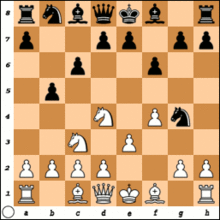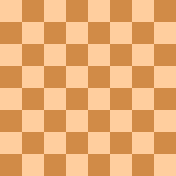
- Chess World Cup
- FIDE Grand Prix
- Olympiad
- World Championship
- List of strong tournaments
- List of world championships

- Checkmate patterns
- Chess openings
- Chess strategy
- Chess tactics
- Chess theory
- Endgames
- Pawn structure
- Problems/Compositions












Atomic chess is a chess variant. Standard rules of chess apply, but all captures result in an "explosion" through which all surrounding white and black pieces other than pawns are removed from play. Some variations additionally remove rules concerning check such that the king may be able to move into or remain in check.
In 1995 the German Internet Chess Server (GICS) introduced the game, based on rules one of its users collected from friends who played offline. It was soon after incorporated into the Middle East Wild Internet Server (MEWIS) and other smaller servers before being implemented at Chess Live and Internet Chess Club in 2000 and Free Internet Chess Server in 2003.
Rules of atomic chess are the same as standard chess with a few important differences concerning capturing, check, and winning conditions.
 A capture in atomic chess. The pawn at g7 is taken by the white knight, causing an "explosion" in which both pieces, as well as the adjacent black bishop and black rook, are removed from play.
A capture in atomic chess. The pawn at g7 is taken by the white knight, causing an "explosion" in which both pieces, as well as the adjacent black bishop and black rook, are removed from play.In standard chess, the captured piece is removed from the board and the capturing piece takes its place. In atomic chess, a capture causes an "explosion" through which both pieces are removed from the board as well as all non-pawn pieces in the eight squares immediately surrounding the capture. Pawns are removed only when capturing, captured directly, or promoted. In case of en passant, the capture is considered to take place on the sixth rank square where the capturing pawn would have landed. Captures that result in the explosion of your own king are illegal, and therefore a king can never capture any other piece.
Threats to the king can be direct or indirect. Putting a king in check is a direct attack and is sometimes called "atomic check." An indirect threat occurs when a player threatens to explode the king by capturing an adjacent piece. In most variations of atomic chess, players must respond to being checked in a similar way they would in traditional chess - by moving the king out of check, blocking the check, or removing the checking piece - but an exception exists when the checked player can win the game by exploding the checking player's king.
As the king cannot take another piece, it is possible to move the kings next to each other without a check occurring.
The variant of atomic chess played at the Internet Chess Club is one that does not enforce check at all, making legal any move, even one leaving the king to be captured directly in the next move.
Position after Rb7:| a | b | c | d | e | f | g | h | ||
| 8 |

   |
8 | |||||||
| 7 | 7 | ||||||||
| 6 | 6 | ||||||||
| 5 | 5 | ||||||||
| 4 | 4 | ||||||||
| 3 | 3 | ||||||||
| 2 | 2 | ||||||||
| 1 | 1 | ||||||||
| a | b | c | d | e | f | g | h | ||
In all variations of atomic chess, a player wins if he or she can explode the king of the opposite color without exploding his or her own king. This is usually done by capturing a piece on a square adjacent to the opponent's king.
In variations that require a response to being checked, it is possible to checkmate an opponent to win the game, creating a situation in which a king is directly threatened and cannot make a legal move. This is sometimes called "atomic checkmate." It is likewise possible for the game to end in stalemate if a king is not directly threatened and no legal moves are possible.
When typical rules of check are not enforced, victory is only attained via the explosion of the enemy king. In these variations without check, the king may be forced into check and thus capture through zugzwang.
| a | b | c | d | e | f | g | h | ||
| 8 |

                                |
8 | |||||||
| 7 | 7 | ||||||||
| 6 | 6 | ||||||||
| 5 | 5 | ||||||||
| 4 | 4 | ||||||||
| 3 | 3 | ||||||||
| 2 | 2 | ||||||||
| 1 | 1 | ||||||||
| a | b | c | d | e | f | g | h | ||
The first-move advantage enjoyed by White is much greater in this game than in standard chess. Hence, it is a game imbalanced against Black. Although the advantage is significant, no attempts to prove a win for white have been successful.
Material sacrifices are more common in atomic chess than in chess. In the opening and middle-game offering it is common to offer a piece in order to seize an initiative enabled by the newly opened spaces captures create.
White has the initiative in atomic chess, and many openings begin with a quick attempt to explode Black's d, e, or f-pawns in front of the black king. For this reason atomic openings are fraught with traps and Black may have to respond precisely to defend. Several common traps begin with 1. Nf3 followed by Ng5 or Ne5, forcing Black to start with 1..f6 to maintain rough equality. Games between experienced players follow more traditional opening principles such as piece development, controlling space, and winning material.
An endgame position| a | b | c | d | e | f | g | h | ||
| 8 |

     |
8 | |||||||
| 7 | 7 | ||||||||
| 6 | 6 | ||||||||
| 5 | 5 | ||||||||
| 4 | 4 | ||||||||
| 3 | 3 | ||||||||
| 2 | 2 | ||||||||
| 1 | 1 | ||||||||
| a | b | c | d | e | f | g | h | ||
As with atomic opening theory, a small amount of endgame theory and analyses have been published online by strong players.
A common scenario in atomic endgames is to have two kings on adjacent squares. As a player cannot intentionally blow up his or her own king, a king can never capture another piece, including another king. Similarly, because a capture affects all adjacent squares, one king cannot be captured directly if it means destruction of the other. Moving one king towards the other is thus a strategy to achieve a draw. The player with the advantage must then maneuver into a position where a non-king piece can be captured that is adjacent to one king but not the other. Creative use of zugzwang is a common tactic to force a win in these situations.
The Internet Chess Club variation of atomic chess ignores check completely, and thus leads to different outcomes in certain situations. For example, a king and rook vs. king endgame that would be a draw under normal circumstances can become a forced win on ICC.